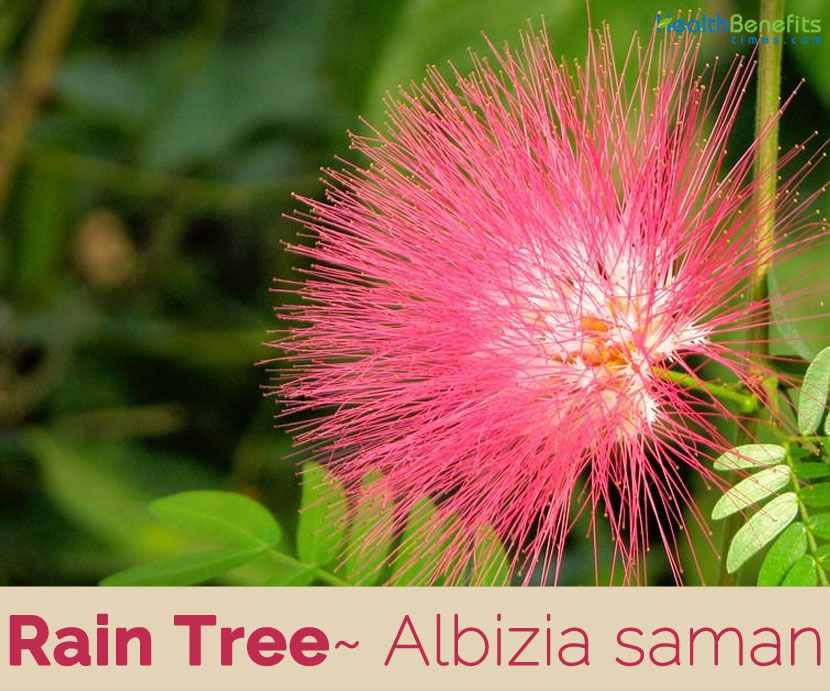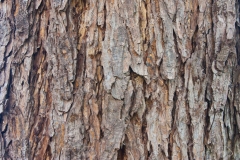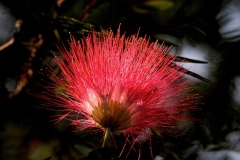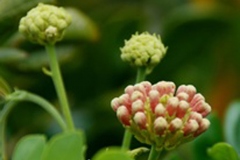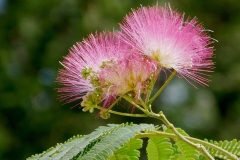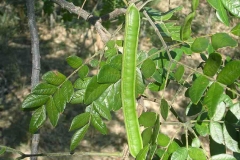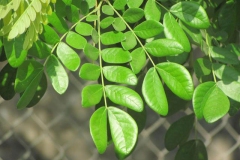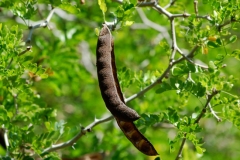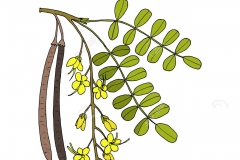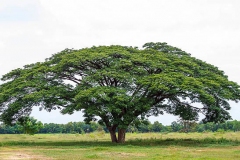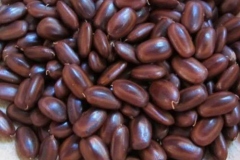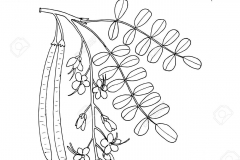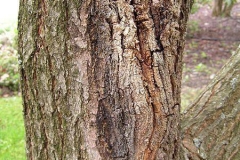It is often placed in the genus Samanea, which by yet other authors is subsumed in Albizia entirely. Genus name honors Filippo degli Albizzia, 18th century Italian naturalist, who introduced the genus to Italy in 1749. It is frequently planted in groups or as an avenue because of its ability to keep its symmetrical conformation in spite of prevailing winds. It is a tree of rapid growth, brought originally from Central America to Sri Lanka and forwarded from there because it was considered to be a tree of great value for railway fuel.
Rain Tree Facts
| Rain Tree Quick Facts | |
|---|---|
| Name: | Rain Tree |
| Scientific Name: | Albizia saman |
| Origin | Northern South America and in Central America as far north as El Salvador |
| Colors | Green when unripe, and turn dark blackish-brown when ripe |
| Shapes | Broadly linear, compressed pods, 10-22 cm long, 1.5-2.2 cm wide and 0.5-1 cm thick |
| Flesh colors | brownish |
| Taste | Sweet, Acidic |
| Health benefits | Beneficial for diarrhea, stomach pain, sore throat, intestinal ailments, blood pressure, headache, tuberculosis and constipation |
| Name | Rain Tree |
|---|---|
| Scientific Name | Albizia saman or Samanea Saman |
| Native | Northern South America (Colombia, the Caribbean slope and the Orinoco drainage of Venezuela), and in Central America as far north as El Salvador. It is now widespread from Mexico south to Peru, Bolivia, and Brazil. In these areas, it occurs in low-elevation dry forests and grassland/savannah habitats. It has been widely introduced to South and Southeast Asia, as well as the Pacific Islands, including Hawaii |
| Common Names | Monkeypod, Acacia Preta, East Indian Walnut, Rain Tree, saman tree, French tamarind, cow tamarind, saman, sirisa, False Powder Puff, Akasya, Akasya, Belati siris, Bodu gas, Campano, Carabeli, Cenizaro, Chaam-churii, Cong, Filiganga, Genixaro, Gouannegoul, Gumorni spanis, Hujan-hujan, Jahmjuree, Kasia kula, Kayu hujan, Marmar, Mohemohe, ‘ohai, Pukul lima, Reethigas, Tamaligi, Tamalini, Thinbaw-kokko, Trong-kon-mames, Vaivai ni vavalangi |
| Name in Other Languages | Afrikaans: Monkeypod Albanian: Monkeypod Amharic: zinijero (ዝንጀሮ) Arabic: Alqurud (القرود) Armenian: Monkeypod Assamese: Sirish goch Azerbaijani: Monkeypod Bengali: Monkeypod, rendi koroi, Biliti siris Bulgarian: Monkeypod Burmese: Monkeypod Chamorro: Tronkon mames Chinese: Hóu zú (猴足), Yu shu, yǔ shù shǔ (雨树属) Carolinian: Filinganga Colombia: Campano, genízaro, samaguare Croatian: Monkeypod Cuba: Algarrobo, algarrobo del pais Czech: Monkeypod Danish: Monkeypod Dominican Republic: Guannegoul Dutch: Monkeypod, regenboom English: Monkeypod, Acacia Preta, East Indian Walnut, Rain Tree, saman tree, French tamarind, cow tamarind, saman, sirisa, False Powder Puff Esperanto: Simiopodo Estonian: Ahvipod Fijian: Vaivai ni vavalagi, vaivai ni vavalangi Filipino: Monkeypod Finnish: Monkeypod French: Singe, Arbre a Pluie, Arbre a la Pluie, samana Georgian: Monkeypod German: Monkeypod, Regenbaum, Schirmbaum Greek: Monópodos (μονόποδος) Grenada: Coco tamarind, cow tamarind Gujarati: Vāndarā (વાંદરા) Guyana: French tamarind Haiti: Guannegoul, samán Hausa: Biri Hawaiian: Ohai, pū ‘ohai Hebrew: קוף Hindi: Monkeypod, Sirsa, Vilayati Siris, belati-siris, guango, majhamaram, nidra-ganneru, thoongh moonjii, Gulabi Siris (गुलाबी सिरिस), Vilaiti siris Hungarian: Monkeypod Icelandic: Apaypod Indonesian: Monkeypod, Dutch tamarind, kihujan, mungur, slubin, trembesi Irish: Monkeypod Italian: Monkeypod, albero delle pioggia Jamaica: Guango Japanese: Sarupoddo (サルポッド), America-nemu Javanese: Monkeypod Kannada: Maṅkipāḍ (ಮಂಕಿಪಾಡ್) Kazakh: Maymıl (маймыл) Korean: Wonsung-I (원숭이) Kurdish: Monkeypod Lao: Monkeypod Latin: Monkeypod Latvian: Pērtiķis Lithuanian: Beždžionė Macedonian: Majmun (мајмун) Malagasy: Monkeypod Malay: Monkeypod Malayalam: Maṅkipēāḍ (മങ്കിപോഡ്) Maltese: Monkeypod Marathi: Monkeypod Mongolian: Sarmagchin (сармагчин) Nepali: Monkeypod Netherlands: Regenboom Norwegian: Monkeypod Oriya: ମାଙ୍କଡପୋଡ୍ | Pashto: بندر Persian: Monkeypod Peru: Huacamayo chico Polish: Małpa Portuguese: Monkeypod, Chorona, burdão de velho, falsa-albízia, samaneiro, samán, árvore-da-chuva Puerto Rico: Crow bean tree, dormilón, giant thibet, guango Punjabi: Bāndara (ਬਾਂਦਰ) Romanian: Monkeypod Russian: Monkeypod Samoan: Tamalini Serbian: Monkeipod (монкеипод) Sindhi: مونيڪوڊڊ Sinhala: Van̆duru poḍ (වඳුරු පොඩ්), Mara Slovenian: Opica Spanish: Monopod, Algarrobo, Arbor De Lluvia, Guango, saman, tamiacaspi, algarrobo del país, zamang Sundanese: Monkeypod Swedish: Monkeypod, regnträd Tajik: Monkeypod Tamil: Kuraṅku pāṭtu (குரங்கு பாட்) Telugu: Monkeypod Thai: Monkeypod Tongan: Kasia Trinidad and Tobago: Coco tamarind, cow tamarind, samán guerra Turkish: Monkeypod Ukrainian: Mavpochka (мавпочка) United States Virgin Islands: Giant thibet, licorice Urdu: بندرکیڈ Uzbek: Maymunpod Venezuela: Campano, carabelí, coují, lara, uero Vietnamese: Khỉpod Welsh: Monkeypod Yapese: Gumor ni spanis Zulu: Monkeypod |
| Plant Growth Habit | Attractive, large, spreading deciduous tree |
| Growing Climates | Dry lowland grassland, coastal bush land, forest, margins of seasonally dry deciduous and semi-deciduous forest, evergreen woodland and savannah, road verges, riverbanks, and forest areas |
| Soil | Adapts to a wide range of soil types and pH levels. Iit tolerates a wide range of light, medium, and heavy soils. |
| Plant Size | Often reaching 15–25 m ( 50-80 ft.) tall, occasionally 50 m( 160 ft.) , with a short stout bole of diameter of 30 m (98 ft.). |
| Bark | Bark of mature trees is gray, rough, and fissured in long plates or corky ridges. Bark is smoother and paler gray to brownish in color on younger tree |
| Twigs | Twigs are stout and green |
| Leaf | Leaves are large, 6-25 mm long and 3-8 cm wide, bipinnate, with 3-6 pairs of pinnae per leaf, 6-9 pairs of leaflets per pinna and large leaflets, 24-62 mm long and 10-25 mm wide. |
| Flowering season | March to May |
| Flower | Tiny flowers (12-25 per head) are massed in pinkish heads 5-6 cm (2-2.4 in) across and about 4 cm (1.6 in) in height |
| Fruit Shape & Size | Broadly linear, compressed pods, 10-22 cm long, 1.5-2.2 cm wide and 0.5-1 cm thick |
| Fruit Color | Green when unripe, and turn dark blackish-brown when ripe |
| Flesh Color | Sticky, brownish |
| Seed | Glossy red brown, ellipsoid, strongly biconvex seeds. They are 8-11.5 mm long and 5-7.5 mm wide, slightly flattened from side to side |
| Propagation | By seed, stem cuttings, root cuttings, and stump cuttings |
| Taste | Sweet, Acidic |
| Plant Parts Used | Entire plant, leaves, inner bark |
| Season | May to October |
| Precautions |
|
Plant Description
Rain Tree is an attractive, large, spreading deciduous tree of potentially great size, often reaching 15–25 m (50-80 ft.) tall, occasionally 50 m (160 ft.), with a short stout bole of diameter of 30 m (98 ft.). It is a stately tree, with heavy, nearly horizontal branches and a distinctive umbrella-shaped crown. The crown is typically broad and domed. The horizontal spread is greater than the height when grown in spacious, open settings. Under plantation conditions, the crown is more vase-shaped. The plant is found growing in dry lowland grassland, coastal bush land, forest, margins of seasonally dry deciduous and semi-deciduous forest, evergreen woodland and savannah, road verges, riverbanks, and forest areas. The plants can adapt to a wide range of soil types and pH levels. It can tolerate a wide range of light, medium, and heavy soils.
Bark
The bark of mature trees is gray, rough, and fissured in long plates or corky ridges. On younger trees the bark is smoother and paler gray to brownish in color. The inner bark is light colored and bitter.
Leaves
Leaves are alternately arranged along twigs and have a prominent swelling (pulvinus) at the petiole base. Stipules are present and are threadlike. Leaves are large, 6-25 mm long and 3-8 cm wide, bipinnate, with 3-6 pairs of pinnae per leaf, 6-9 pairs of leaflets per pinna and large leaflets, 24-62 mm long and 10-25 mm wide. Leaflets are unequal in size, becoming larger towards the distal end of the pinnae. The new growth and leaf rachis are covered in short, velvety, tawny pubescence. The leaflets are rhombic-oblong or elliptic in shape, unequal at the base, dark olive-green, glabrous and slightly glossy above, dull grey-green and hairy below.
During dry periods trees are semi-deciduous, losing their leaves for a short period. Where there is a definite dry season, they may remain leafless for a period of weeks but refoliate speedily if there is sufficient moisture. This gives the appearance that rain tree is “evergreen” in moister climates.
Flowers
The flowers are arranged in loose umbelliform heads, which develop in groups of 2-5 in the axils of leaves on actively growing shoots. The terminal or central flower on each head is sessile and enlarged compared to the peripheral flowers. The tiny flowers (12-25 per head) are massed in pinkish heads 5-6 cm (2-2.4 in) across and about 4 cm (1.6 in) in height. The long, bicolored stamens (white in lower half and reddish above) give the whole inflorescence the appearance of a powder puff or feather duster held slightly above the foliage. Thousands of heads are borne at the same time, covering the tree in pinkish bloom. The central flower in each head is larger, stalk less, has more petals, and is in-capable of forming a fruit. This flower is a nectar-producing organ that attracts pollinators. Usually only one flower per head (rarely two) is pollinated and forms a fruit. Flowering normally takes place in between March to May.
Fruit
Fertile flowers are followed by broadly linear, oblong, lumpy, compressed pods, 10-22 cm long, 1.5-2.2 cm wide and 0.5-1 cm thick, straight or slightly curved, not dehiscing but eventually cracking irregularly, and filled with a dry pitch-like sticky, brownish pulp that is sweet and edible. They are green and fleshy when unripe, and turn dark blackish-brown when ripe. The pods do not readily open and remain on trees for long periods.
Seed
The pods are indehiscent and contain glossy red brown, ellipsoid, strongly biconvex seeds. They are 8-11.5 mm long and 5-7.5 mm wide, slightly flattened from side to side, with a characteristic U-shaped pleurogram. There are 15-20 seeds per pod (often only 5-10 seeds per pod in the native range). One kilogram of seeds averages 4000-6000 seeds (1820-2730 seeds/lb.). Seeds are readily dispersed by domestic livestock (cattle, hogs, goats) and to a much lesser extent by wild animals (peccary, tapir, and rodents in the presumed native range), whose feeding habits and digestive capacity permit very few seeds to pass through intact.
Traditional uses and benefits of Rain Tree
- The plant is used in the treatment of diarrhea, stomach pain, and sore throat.
- Decoction of the inner bark and fresh leaves is used as a treatment for diarrhea.
- A brew of small sections of the bark is taken to treat stomach-ache.
- A crude aqueous or alcoholic extract of the leaves is observed to have an inhibiting effect on Mycobacterium tuberculosis.
- The alkaloid fraction of the leaves is effective on the CNS and PNS.
- An infusion of the leaves is used as a laxative.
- The fruit decoction is used as a CNS-sedative.
- The seeds are chewed for treating a sore throat.
- Inner bark decoction and fresh leaves are used for cold and diarrhea.
- In Pakistan infusion of the leaves are used as laxative.
- Decoction of inner bark is used for diarrhea, cold and intestinal ailments.
- In Jamaica leaf infusion is used for treating blood pressure.
- In tropical Africa seeds are chewed for treating gum and throat inflammation.
- In Venezuela rain tree is a traditional remedy for cold, diarrhea, headache, intestinal ailments and stomach ache.
- Root decoction is used in hot baths for stomach cancer.
- In the West Indies, leaf infusion is used as a laxative and seeds chewed for sore throat.
- The alcoholic extract of leaves is used for tuberculosis.
- In Columbia, fruit decoction is used as a sedative.
- In the Philippines, a decoction of the inner bark or fresh cambium and leaves is used to treat diarrhea.
- A decoction of the inner bark or fresh cambium and leaves is used to treat diarrhea.
- In the West Indies the leaves are chewed to relieve toothache.
- An infusion of the leaves is given for constipation.
- A boiled bark poultice is used to cure constipation too
Different Uses and products
Rain tree has long been a source of timber and livestock feed (green forage and pods) for local consumption. Minor medicinal and craft uses also are known. The wood is used for carving items for sale to tourists, and the seeds are strung in garlands.
1. Fruit
The sticky, licorice-flavored fruit pulp is a minor food item for humans, mainly eaten by kids. It is known as licorice tree in the English-speaking Caribbean. Although the pods have a nice flavor, they are too astringent to eat more than the pulp from a single pod.
2. Nut/seed
Seeds, once cleaned from the sticky fruit pulp, are used in making seed necklaces and other craft items in Hawaii.
3. Animal fodder
With 13-18 % protein, the pods are edible and nutritious for livestock and make an excellent feed supplement. Rain tree is grown as a green fodder supplement for goats, sheep, and cattle in Asia. A 5 year-old tree can produce as much as 550 kg (1210 lb.) of green forage. The pods are ground into a nutritious animal feed in several South American countries.
4. Beverage/drink/tea
The fruit pulp is used to make a beverage similar to tamarind (made from tamarind pulp) in Latin America.
5. Medicinal
There are numerous folk remedies prepared from various parts of rain tree. The boiled bark is applied as a poultice to cure constipation. In the Philippines, a decoction of the inner bark and fresh leaves is used for diarrhea. In Venezuela, the roots are made into a hot bath for stomach cancer. In the West Indies, the seeds are chewed for sore throat.
6. Beautiful/fragrant flowers
Rain tree has been presented to many tropical places for the beautiful masses of pinkish flowers it bears for extended periods.
7. Timber
Timber is valued for carvings, furniture, paneling, veneers, and is also used for turnery, posts, framing in boat building, plywood, boxes, and crates. Sapwood is narrow and white to light cinnamon. The heartwood is straight or cross grained with a medium to coarse texture. Air-dry specific gravity averages about 0.56. The wood requires careful drying because of shrinkage and moderate to severe warp. It is generally considered a durable wood and resistant to attack by dry wood termites.
8. Fuel wood
In places where there is no demand for rain tree timber for construction or carving, the trunk and branches are used for firewood and charcoal. Though the wood makes good firewood, it burns with a lot of smoke even when very dry.
9. Craft wood/tool
The famous monkey pod bowls of Hawaii and other souvenirs are carved from the wood. Rain tree wood was literally the basis for this industry beginning just after World War II ended.
10. Ornament/decoration
The seeds are used in making seed necklaces, jewelry, and other crafts in Hawaii.
11. Canoe/boat/raft making
The wood is popular for large frame members in wooden boats.
12. Fiber/weaving/clothing
Wood has the right fiber properties for making paper. In the Philippines (Bulacan province), shavings made from the wood are made into hats.
13. Resin/gum/glue/latex
Low-grade gum exudes from wounded trees. It has no commercial use but may be used locally. In Thailand, rain tree is used as a food source for the lac insect, the source of shellac.
14. Honey
Honey made from rain tree nectar is collected in several places for local consumption but is not an item of commerce.
15. Use as living fence, hedge or visual/noise barrier
In the Pacific, rain tree is not used as a hedge or living fence. In Asia, the trees are used as a hedge, with heavy trimming required to maintain a compact growth form. Trimmings are used for livestock feed or green manure.
Culinary Uses
- Pods can be eaten and the pulp can be made into drink.
- Children eat the pods, which contain a brownish, sticky, licorice-like, sweet-flavored pulp.
- Lemon-like fruit drink is also made from the pulp.
- Tree yields a gum of inferior quality which could be used as a poor man’s substitute for gum Arabic.
Other Facts
- Rain Tree is a multi-purpose tree often cultivated for its timber and as food, medicine, and gums among others.
- The tree is grown to provide shade for other crops, including cocoa, coffee, tea and peppers.
- Pods can be ground up and converted to alcohol as an energy source.
- Wood is light in weight and is used for carvings, furniture, paneling, boat building, interior trim, crafts, boxes, veneers, and general construction.
- Bark is an abundant source of gums and resins.
- In Hawaii, bowls and other craft products made from the wood are in such high demand that the local wood supply is supplemented by imports from Indonesia and the Philippines.
- Moderately durable wood, it is also used in boat building.
- The wood is very durable against rot and termites.
- The wood also makes good quality fuel wood and charcoal.
References:
https://www.itis.gov/servlet/SingleRpt/SingleRpt?search_topic=TSN&search_value=520959#null
http://www.hear.org/pier/species/samanea_saman.htm
https://npgsweb.ars-grin.gov/gringlobal/taxon/taxonomydetail?id=32979
https://pfaf.org/user/Plant.aspx?LatinName=Samanea+saman
https://www.cabi.org/isc/datasheet/4026
http://www.missouribotanicalgarden.org/PlantFinder/PlantFinderDetails.aspx?taxonid=280418
https://plants.usda.gov/core/profile?symbol=SASA10
https://www.nparks.gov.sg/florafaunaweb/flora/3/1/3106
https://en.wikipedia.org/wiki/Samanea_saman
https://www.researchgate.net/publication/311667816_Samanea_saman_rain_tree
http://tropical.theferns.info/viewtropical.php?id=Samanea+saman
http://tn-grin.nat.tn/gringlobal/taxonomydetail.aspx?id=32979
http://www.theplantlist.org/tpl1.1/record/ild-32292
https://indiabiodiversity.org/species/show/228648
http://www.flowersofindia.net/catalog/slides/Rain%20Tree.html
https://keyserver.lucidcentral.org/weeds/data/media/Html/samanea_saman.htm
https://gd.eppo.int/taxon/PIFSA


